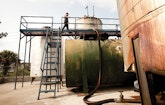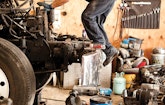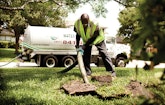
Interested in Plumbing?
Get Plumbing articles, news and videos right in your inbox! Sign up now.
Plumbing + Get AlertsWhen old-line pumping company Brownie's Wastewater Solutions became a subsidiary of publicly held Freedom Environmental Services, the goal was to establish a one-stop waste-handling service company for restaurants, hotels and convention centers.
The Orlando, Fla., based Brownie's – in business since 1948 – has become a greatly diversified service provider over the past few years, doubling the customer accounts and making "recycling'' the watchword in every move the company makes.
In 2010, Brownie's acquired Vac and Jet, a municipal and industrial cleaning and treatment service. The company then purchased Grease Tec from Clean Fuels, a full-service cooking oil collection and rendering business, and rolled it into another Freedom subsidiary, Grease Recovery Solutions.
Within months, Brownie's grew from 25 employees with more than 1,000 commercial accounts to 43 employees with more than 2,500 commercial accounts, including Pepsi, a major entertainment park/resort, Coleman Federal Correction Complex, and utility companies such as Toho Water Authority. Revenue increased from $293,000 in 2009 to $6 million in 2011. "We were rocking and rolling," says operations manager Rafael Benitez. That had not always been the case.
ADAPT, OVERCOME
In 2008, financial difficulties threatened Brownie's existence. To survive, the company adjusted payroll and refocused its core businesses: restaurant services, septic tank cleaning and vacuum loading. A manager was hired for each department: Danny Floyd, regional sales for Grease Recovery Solutions; Mike Gignac, plumbing; Tammy Steen, Grease Recovery Solutions; Monica Swearingen, business; and Steve Catania, lift station. Today, commercial, industrial and municipal customers account for 60 percent of the company's revenue, and residential the remainder.
Brownie's had pumped septic tanks and grease traps since its inception, but adapting to cooking oil customers took a while. Making certain they were serviced correctly was challenging due to rapid turnover in the restaurant and hospitality industry. "How we care for customers is a major selling point," Floyd says. "We build face-to-face relationships that are very important to us, and each turnover set that effort back a little."
Bolstering those new relationships, a sales team went after diverse work, including drain cleaning, plumbing and waterjetting. Most customers welcomed vendor consolidation, especially after hearing that Brownie's had no overtime, after-hours or trip charges. "We work around the clock throughout the year, enabling us to charge our normal hourly rate plus materials," Floyd says.
EQUIPMENT CHOICES
At the time Brownie's purchased Clean Fuels, the company was moving to an 8,000-square-foot warehouse with office, and had yet to hook up any equipment. The Orange County Health Department saw only a new business that needed permitting. One requirement was to build a 16- by 16-foot containment pad with retaining walls and drainage area to capture spills or tank ruptures.
"We designed the grease rendering system as one unit," Floyd says. "The brown grease process is on the left, the yellow grease process is on the right and the boiler and generator are in the middle." Grease Recovery Solutions opened in February 2011.
Brownie's 15 vacuum trucks and four 6,200-gallon stainless steel Model L-7035 tractor-trailer tankers, built by Walker Trailers, deliver grease trap waste and cooking oils to the plant. The latest addition to the vacuum fleet is a 2012 Freightliner with 4,800-gallon aluminum Progress Vactruck, heated collars, Masport VTK-650 pump, and 350 cfm forced-fan air-cooled rotary vane pump. The majority of the other vehicles, built by Presvac Systems, are 1999 to 2003 Powervac PV-4200s on Freightliner, International and Sterling chassis with 4,000-gallon aluminum tanks and Masport pumps.
Most trucks also have 622S Harben jetters (4.5 gpm/4,000 psi) because the city and surrounding areas require grease traps and interceptors to be pressure washed after pump-out. (Orlando alone has more than 4,500 restaurants and more than 450 hotels, most on a 90-day service schedule.) As a complimentary service, Brownie's pressure washes customers' aboveground collection containers and the site monthly.
"Employees dump oil at night and it flies all over," Floyd says. "Cleaning the area prevents slips and falls. It's important to provide a safe environment for our customers and our technicians." The cleaning crew drives a Ford F-450 pickup truck with lift gate carrying degreaser, a Steam Genie heated pressure washer from Alkota, and a 500-gallon tank from Dyna-Vac Equipment to handle the dirty water.
PROCESSING GREASE
Trucks arriving at the rendering facility offload into separate screening boxes to catch debris. Cooking oil then flows to one of two 20,000-gallon settling/mixing tanks. When a batch is ready for rendering, it is piped to a 15,000-gallon tank with inline heaters and thermostats. The liquid that rises to the surface is No. 1 grade yellow grease, while the unusable fines settle to the bottom and are siphoned off.
A proprietary press dewaters the fines. Water then flows through a chemical treatment process using Alar Engineering Corp. equipment to disinfect it before being stored in two 7,500-gallon tanks. Technicians test the water continually to ensure that it meets reuse standards.
"We haven't begun to recycle it because we're still looking for applications," Floyd says. "Some outlets under consideration are concrete batching plants, dust control at construction sites, and landscape and agricultural irrigation. Customers can haul the water away for free or we'll deliver it for a fee."
It takes 9,000 gallons of cooking oil to produce 6,000 gallons of No. 1 grade yellow grease. The facility processes one million gallons per year, but has capacity for 3.3 million gallons.
Brownie's fabricated its own processing components for grease trap waste, which is mostly water. After screening the grease, it is pumped to two 20,000-gallon mixing tanks that heat it to 180 degrees, separating it from the water. The oil, piped to the boiler, is reheated to separate residual water, then stored in tanks until there is enough to sell. The process produces 250,000 gpd of water, which flows through the Alar system and into the 7,500-gallon storage tanks.
The operation, running at 80 percent of design capacity, produces 10 million gallons of oil per year. Both types of oil are sold to commodities brokers for resale as renewable energy or livestock feed. "We can't produce enough to meet demand," Floyd says. "The grease is sold before we even cook it."
Local municipalities experimenting with biosolids and recycled oil as fuel are another market for the product. "They're buying No. 1 grade yellow grease in 100-gallon increments," Floyd says. "Although still in the beginning stages, the experiment is working well and has great potential."
ADDED SERVICE
Resorts, conference hotels, and large restaurants often have infrastructure for transporting grease to collection points. Cleaning the infrastructure is part of Brownie's one-stop service package. One major customer, a theme/resort in central Florida, has 54 traps holding 40 to 12,000 gallons and four lift stations.
"We remove 1 million gallons of brown grease annually," Benitez says. "Every 14 days, crews pressure wash the grease lines in the busiest area of the park. We also jet the complex's 34,213 feet of 8- to 24-inch ductile iron and PVC sanitary sewers annually, and the stormwater conveyance system as needed."
Brownie's built its own inspection truck, then outfitted it with CUES equipment. Jetting crews use 2007 and 2008 Vactor 2100 series combination sewer cleaners built on International chassis with 15-cubic-yard debris bodies, 1,500-gallon water tanks, 4,500 cfm/18-inches Hg Dresser Roots (now GE Water & Process Technologies) positive displacement blowers, and 80 gpm/2,000 psi waterjetting systems.
If access is a problem, they use trailer-mounted 600-gallon hydrojetters from Harben and US Jetting. Ford F-450 pickups with hydraulic hoists enable them to pull or install pumps and rails in lift stations. There also is a fleet of plumbing vehicles to repair those problems.
FORWARD THINKING
With Grease Recovery Solutions running smoothly, the company is concentrating on recycling septage. Haulers currently deliver it to Ag Environmental Solutions in Fort Meade for dewatering and land application or landfilling.
"We're working with the Florida Industrial Pretreatment Association to learn new techniques to dewater septage and produce Class A biosolids for fertilizer," Floyd says. "Our goal is to produce Class A EQS, which is exceptional quality sludge, and maybe add a septage receiving facility to our operations."
In 2010, the pretreatment association launched CORE, its cooking oil recycling effort designed to reduce sewer overflows. As a CORE sponsor, Brownie's occasionally covers the cost of association workshop lunches or networking meetings, or gives presentations on its grease recovery program.
Grease Recovery Solutions also works with the City of Orlando and Orange County officials, encouraging homeowners to recycle their cooking oil instead of pouring it down the drain. "Whenever technicians respond to residential service calls, they discuss the issue and leave pamphlets," Floyd says.
Within five years, they would like Brownie's to stop taking waste to the landfill, end land application, reuse all waste byproducts and grow the cooking oil operation by acquiring larger accounts.
"Although we're very busy, I see the potential to realize different techniques and continue expanding," Floyd says.









